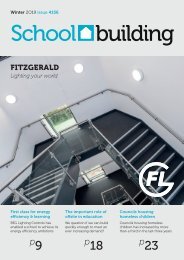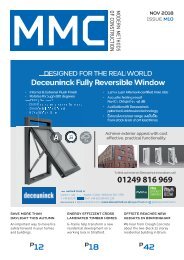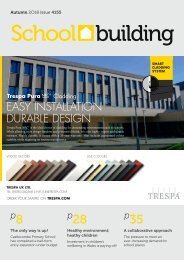Create successful ePaper yourself
Turn your PDF publications into a flip-book with our unique Google optimized e-Paper software.
External Building Envelope<br />
This is <strong>MMC</strong>… but not as we know it<br />
Advances in construction techniques over the past decade have given rise to some genuine commercial, sustainable and health and<br />
safety benefits – all while improving efficiency and performance.<br />
However, as building regulations are<br />
updated over time and standards<br />
become increasingly stringent, these<br />
modern methods of construction risk failing to<br />
keep pace, particularly where thermal<br />
insulation is concerned. Chris Lea, Technical<br />
Sales Manager, SIG Performance Technology,<br />
explores why the construction sector needs to<br />
rethink its approach to reducing heat loss in a<br />
building and why the aerospace industry<br />
appears to hold the answer.<br />
Some of the major specification drivers for<br />
building design in modern times are the need to<br />
keep building footprint to a minimum, maximise<br />
internal rentable space and achieve the highest<br />
energy efficiency performance possible.<br />
Working within the confines of these design<br />
objectives, developers must also achieve<br />
accelerated build programmes in a bid to<br />
complete within budget and realise the return<br />
on investment as promptly as possible.<br />
Fast track construction which uses steel or<br />
timber frame has become a tried and tested<br />
build method in the UK, particularly in high rise<br />
developments. As the exterior of these buildings<br />
is commonly a cladding finish, the challenge of<br />
reducing heat loss while maximising internal<br />
floor space and minimising building footprint<br />
comes to the fore. Crucially, the insulation has<br />
to be installed within the through-wall build up,<br />
but this construction suffers from cold bridging<br />
as soon as the rainscreen carrier system is<br />
installed. This is where innovative new<br />
insulation techniques are helping modern<br />
construction techniques to stay at the forefront.<br />
Helping hands<br />
The availability of 3D thermal modelling has<br />
proven a valuable technology in assisting the<br />
development of new solutions which address<br />
current construction challenges. After reviewing<br />
thermal models of buildings using rainscreen<br />
systems, the innovation team at SIG<br />
Performance Technology identified high levels of<br />
heat loss being caused by the helping hand<br />
bracketry in the support systems. Realising that<br />
a reduction in the cold bridging through the<br />
bracketry would significantly improve the overall<br />
performance of the building envelope, research<br />
began into developing an insulated clip-on<br />
solution.<br />
After a programme of development, aerogel –<br />
most commonly used in aerospace and<br />
industrial applications – emerged as the most<br />
suitable insulant owing to its exceptional<br />
thermal performance and proven flexible<br />
properties. This led to the launch of CHI-<br />
GASKET, a patented insulated component which<br />
is simply clipped on to standard helping hand<br />
bracketry on-site. In doing so, the cold bridging<br />
is significantly reduced and means the<br />
insulation within the<br />
through-wall buildup<br />
does not have to<br />
compensate for this<br />
and consequently<br />
does not have to<br />
achieve such low U-<br />
Values. It is because<br />
of this that the CHI-<br />
GASKET is now<br />
considered from<br />
initial design stage.<br />
Aerogel in<br />
action<br />
The use of Aerogel<br />
as an insulant in<br />
helping hand<br />
bracketry is a unique application but one where<br />
a change in design process has enabled major<br />
developments to achieve core design objectives.<br />
This principle is also now being applied in<br />
modular buildings and offsite construction,<br />
where linear areas of heat loss at construction<br />
junctions prove a common challenge.<br />
As the modular buildings typically have much<br />
tighter junctions than those constructed onsite,<br />
these developments present several<br />
challenges. Firstly, lower density insulation is<br />
more flexible and easier to install into tight<br />
frames, but these materials are generally<br />
lower performing from a thermal perspective.<br />
Secondly, rigid materials offer good thermal<br />
insulation, but require cutting to size, either<br />
on or off-site, which adds a layer of<br />
complexity to the construction process.<br />
Finally, both of these methods leave room for<br />
installation error, as the materials are being<br />
cut to size or pushed into place manually.<br />
Offering a solution to this challenge is<br />
Aerogel. The material can be precision cut to<br />
size and fabricated to any bespoke shape to<br />
meet the exact needs of modular building<br />
specifications. Thermally excellent yet<br />
flexible, precision manufactured aerogel<br />
linings would deliver a much greater level of<br />
quality control and reduce labour time in<br />
construction – all of which align with modern<br />
methods of construction.<br />
While the name Aerogel is probably more<br />
synonymous with NASA than with <strong>MMC</strong>, as the<br />
construction market continues to innovate<br />
with insulation, this could be set to change in<br />
the not so distant future.<br />
www.sigpt.co.uk/chigasket<br />
36 <strong>MMC</strong><br />
Nov 2018 <strong>M10</strong>
















